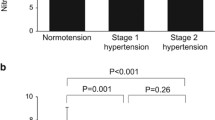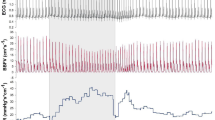Summary
It is not known whether hypertrophic cardiomyopathy (HCM) is accompanied by an abnormality in vascular smooth muscles. In this study, we examined the maximal vasodilator capacity of forearm resistance vessels by measuring minimal forearm vascular resistance (min. FVR) during peak reactive hyperemia after 10 min of arterial occlusion in patients with HCM (n=15, 41±4 years old) and age-matched control subjects (n=12, 42±3 years old). Forearm blood flow (FBF) was measured by a mercury-in-silastic strain gauge plethysmograph and FVR was calculated by dividing mean blood pressure by FBF. Resting FBF was lower (P<0.05) and resting FVR was higher (P<0.01) in patients with HCM than in control subjects. Min. FVR was significantly greater in patients with HCM than in control subjects (2.7±0.2 vs 1.5±0.2 units,P<0.005). We also examined vasoconstrictive responses to intra-arterially infused angiotensin II (20 and 40 ng/min); responses were greater in patients with HCM than in control subjects (P<0.05). These results indicate that forearm circulation is altered in patients with HCM. The result that the maximal vasodilator capacity of forearm resistance vessels is limited in patients with HCM as compared with that in age-matched control subjects suggests that there may be abnormalities in forearm resistance vessels in patients with HCM, which might involve increased wall thickness or intrinsic abnormalities in vascular smooth muscle.
Similar content being viewed by others
References
James TN. Marshal TK (1975) De subitaneis mortibus, XII, Asymmetrical hypertrophy of the heart. Circulation 51: 1149–1166
McReynolds RA, Roberts WC (1975) The intramural coronary arteries in hypertrophic cardiomyopathy (abstract). Am J Cardiol 35: 154
Roberts WC (1979) Congenital cardiovascular abnormalities usually “silent” until adulthood: Morphologic features of the floppy mitral valve, valvular aortic stenosis, hypertrophic cardiomyopathy, sinus of Valsalva aneurysm and the Marfan syndrome. Cardiovasc Clin 10: 407–453
Marron BJ, Wolfson JK, Epstein SE, Roberts WC (1986) Intramural (“Small Vessel”) coronary artery disease in hypertrophic cardiomyopathy. J Am Coll Cardiol 8: 545–557
Tanaka M, Fujiwara H, Onodera T, Wu D-J, Matsuda M, Hamashima Y, Kawai C (1987) Quantitative analysis of narrowings of intramyocardial small arteries in normal hearts, hypertensive hearts and hypertrophic cardiomyopathy. Circulation 75: 1130–1139
Takeshita A, Mark AL (1980) Decreased vasodilator capacity of forearm resistance vessels in borderline hypertension. Hypertension 2: 610–615
Takeshita A, Imaizumi T, Ashihara T, Yamamoto K, Hoka S, Nakamura M (1982) Limited maximal vasodilator capacity of forearm resistance vessels in normotensive young men with a familial predisposition to hypertension. Circ Res 50: 671–677
Conway J (1963) A vascular abnormality in hypertension: A study of blood flow in the forearm. Circulation 27: 520–529
Zelis R, Mason DR, Braunwald E (1960) A comparison of the effects of vasodilator stimuli on peripheral resistance vessels in normal subjects and in patients with congestive heart failure. J Clin Invest 47: 960–970
Greenfield ADM, Whitney RJ, Mowbray JF (1963) Methods for the investigation of peripheral blood flow. Br Med Bull 19: 101–109
Imaizumi T, Takeshita A, Ashihara T, Nakamura M (1985) The effects of sublingual nitroglycerin on forearm vascular resistance in patients with heart failure and normal subjects. Circulation 72: 747–752
Folkow B, Grimby G, Thulesivs O (1958) Adaptive structural changes in the vascular walls in hypertension and their relation to the control of peripheral resistance. Acta Physiol Scand 44: 255–272
Folkow B (1971) Hemodynamic consequences of the adaptive structural changes of the resistance vessels in hypertension. Clin Sci 41: 1–12
Sivertson R (1970) The hemodynamic importance of structural vascular changes in essential hypertension. Acta Physiol Scand (Suppl) 343: 6–56
Sax FL, Cannon RO III, Hanson C, Epstein SE (1987) Impaired forearm vasodilator reserve in patients with microvascular angina, evidence of a generalized disorder of vascular function? N Engl J Med 317: 1366–1370
Sutton MGStJ, Tajik A, Smith HC, Ritman EL (1980) Angina in idiopathic hypertrophic subaortic stenosis. A clinical correlation of regional left ventricular dysfunction. A videometric and echocardiographic study. Circulation 61: 561–568
Hutchins PM, Carnell AE (1974) Observation of a decreased number of small arterioles in spontaneously hypertensive rats. Circ Res 34, 35 (Suppl I): 161–165
Folkow B, Hallback M, Kundgren Y, Sivertson K, Weiss L (1973) Importance of adaptive changes in vascular design for establishment of primary hypertension studied in man and in spontaneously hypertensive rats. Circ Res 32 (Suppl): 2–12
Lorell BH, Paulus WJ, Grossman W, Wynne J, Cohn P (1981) Modification of abnormal left ventricular diastolic properties by nifedipine in patients with hypertrophic cardiomyopathy. Circulation 3: 499–507
Abboud FM, Eckberg DL, Johannsen UJ, Mark AL (1979) Carotid and cardiopulmonary baroreceptor control of splanchnic and forearm vascular resistance during venous pooling in man. J Physiol 286: 173–184
Author information
Authors and Affiliations
Rights and permissions
About this article
Cite this article
Imaizumi, T., Takeshita, A., Yamamoto, K. et al. Limited maximal vasodilator capacity of forearm resistance vessels in patients with hypertrophic cardiomyopathy. Heart Vessels 5, 159–165 (1990). https://doi.org/10.1007/BF02059911
Received:
Revised:
Accepted:
Issue Date:
DOI: https://doi.org/10.1007/BF02059911




